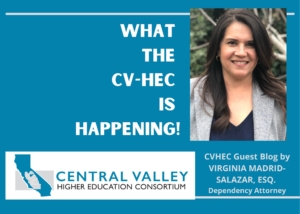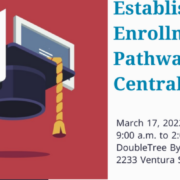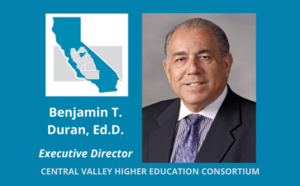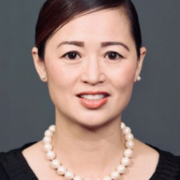Virginia Madrid-Salazar, Esq., was CVHEC’s strategies lead from 2015 through July 2021. In August, the San Joaquin College of Law alumna’s service to her community shifted to private law practice as a dependency attorney serving parents and minors involved in Dependency Court of the Fresno County Superior Court. She is also a board member of the Fresno County Office of Education Foundation. Not only did she utilize her skills while at CVHEC to help develop dual enrollment strategies with CVHEC member institutions and educational partners, Virginia also supported her own son’s productive dual enrollment journey – so we asked her to share some observations on dual enrollment from this unique perspective for our fourth “What the CV-HEC is Happening” Blog.
Dual enrollment: an equity change-maker
By Virginia Madrid-Salazar, Esq.
As the strategies lead for the Central Valley Higher Education Consortium, it was an honor to work alongside area educators to affect transformational changes that have occurred in the region’s higher education sphere during that period.

This blog entry gives me a welcome opportunity to share my perspective, first, reflecting on the dual enrollment work that CVHEC champions; experiencing dual enrollment in my own son’s educational career; and lastly, expressing my hope for where the Central Valley will go with dual enrollment. As a dependency attorney, I welcome the push of dual enrollment for foster youth.
Energizing for Dual Enrollment Despite Pandemic Limitations
Right before the pandemic hit, on March 5, 2020 CVHEC hosted a groundbreaking event for Central Valley higher education and K-12 educators. Nearly 200 interested educators gathered to create an action plan to create a dual enrollment model that improved the delivery of dual enrollment for the Central Valley’s rural and urban communities.
It was an energizing event. A CVHEC-convened taskforce primed the agenda to allow colleagues an opportunity to identify shared barriers to dual enrollment and devise action plans to dismantle those barriers. This collaboration proactively allowed for a valley-wide approach.
Among the needs that emerged included improving CCCApply for dual enrollment students (the application was not originally designed for use by high school students taking college-credit bearing courses and it showed); and the simple fact that not enough teachers met minimum qualifications Ito teach college courses on their high school campuses.
During the pandemic, CVHEC brought those interested parties together virtually via Zoom where these challenges were further examined and solutions were crafted.
Application Frustrations Raised and Fixed
An executive committee of the task force identified frustrations experienced by Central Valley students when enrolling in dual enrollment courses. These concerns were shared with the California Community College Chancellor’s Office team working to improve the application process.
As a result, improvements have been implemented and there are more students now overcoming that barrier.
Growing Dual Enrollment Teachers on High School Campuses
CVHEC got to work on another barrier and organized grant applications to the Fresno K-16 Collaborative to fund high school English and math teachers to earn their master’s degrees (see Dual Enrollment Upskilling Teachers Master’s Program). In December 2021, the first of three cohorts completed their degrees. Not only will these teachers teach dual enrollment courses on high school campuses, but some will serve at rural high school campuses where the need is great.
These efforts are the beginnings of improving dual enrollment for Central Valley students.
Improving dual enrollment access does not necessarily mean a student must earn their associate degree by the time they finish high school either. Rather, the opportunity to take at least six units of college-credit bearing courses – especially an English or math course – before they finish their high school career can transcend a student’s outlook on their college career.
That was my son’s experience.
Students Getting a Head Start in College Career
In his senior year of high school, my son enrolled in six units of college credit-bearing course work taking Communications and English 1A. It was the first he heard of these dual enrollment classes offered on his campus and he decided he would give it a shot. Not only did he find the course work and his instructors interesting (he earned A’s in both courses) but, perhaps more importantly, he saw himself as a college student – in that moment.
“That dual enrollment is clutch!” That was his exclamation in our kitchen with his ed plan in hand. It was clear to him he was free to take a few other courses he needed to transfer to his choice school. This was all because he got a head start on his college career with dual enrollment. All I could do was smile.
Unbridled excitement for his future. It’s an indescribable feeling to see the positive impact of transformational change. That must be what our Central Valley higher education leaders pursue as they explore how to grow dual enrollment in the valley.
Opportunities to Grow Dual Enrollment – Equitable Growth
That excitement I saw in my son – a mix of relief, inspiration and a vision he saw for himself – is for everyone. Growing dual enrollment offers an equitable growth opportunity. As of late, I’ve noticed a push for foster youth in dual enrollment. (See Career Ladders Project Dual Enrollment for Foster Youth: Toward Effective Practice.) Now as a Dependency Attorney, and not someone in the daily challenge of growing dual enrollment, I see the experiences foster youth endure and the resiliency they display and I applaud this push on their behalf.
This is where I have a unique perspective. I can see the transformation that can occur for foster youth if they participate in dual enrollment – even if it’s a few college courses. Not just because of the impact higher education can have on someone’s life, but because for a senior who is living life as a foster youth, a lot rides on that last year of high school. Let me explain.
When foster youth are not reunified with their family as they near the age of majority, they may continue to receive County support through age 21 if they work or attend college through what is known as AB 12 Extended Foster Care Program and Benefits. If foster youth can envision themselves as college material while in high school that young person will be inclined to participate in AB 12 and pursue a college education. This is a decision they make during that last year of majority or their senior year of high school. I cannot emphasize enough how a dual enrollment opportunity can transform that young person’s life.
Simply put, in all its fashions, dual enrollment cannot be denied in its ability to create long-lasting, unimaginable change.
Yes, it was such an honor to lend my skill through CVHEC to help Central Valley educators create transformational change.
I cannot wait to see what transformations take shape in the next few years and what other barriers to dual enrollment Central Valley educators will dismantle.
Check the CVDEEP Convening Website for updates and follow-up of the March 17, 2022 event.
See CVHEC White Paper Released: ‘Dual Enrollment in the Central Valley: Working Toward a Unified Approach for Equity and Prosperity’





 Congratulations to Dr. Lena H. Tran, a San Jose City College vice president, on her
Congratulations to Dr. Lena H. Tran, a San Jose City College vice president, on her 